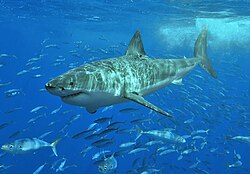Our website is made possible by displaying online advertisements to our visitors.
Please consider supporting us by disabling your ad blocker.
Great white shark
| Great white shark | |
|---|---|

| |
| Scientific classification | |
| Kingdom: | |
| Phylum: | |
| Class: | |
| Subclass: | |
| Order: | |
| Family: | |
| Genus: | |
| Species: | C. carcharias
|
| Binomial name | |
| Carcharodon carcharias (Linnaeus, 1758)
| |

| |
| Range (in blue); in the dark blue areas the sharks are more common | |

The great white shark (Carcharodon carcharias), also known as the white shark, is a species of mackerel shark. It is the world's largest living predatory fish. Mature sharks may grow up to 6.4 m (21 ft) in length and 3,324 kg (7,328 lb) in weight.[1][2][3][4] There also have been a few reports of great white sharks measuring over 8 m (26 ft).[5] This shark reaches its sexual maturity around 15 years of age. The lifespan of a great white shark may be as long as 70 years or more.[6] Great white sharks can accelerate to speeds over 56 km/h (35 mph).[7]
Great white sharks have about 300 teeth, arranged in many rows.[8] The first two rows of the teeth are used for grabbing and cutting the animals they eat, while the other teeth in the last rows replace the front teeth when they are broken, worn down, or when they fall out. The teeth have the shape of a triangle with jags on the edges. Great white sharks are carnivores. The great white sharks is an apex predator. It hunts fish, seals, sea lions, seagulls, penguins, squid, octopuses, dolphins, small whales, crabs, shrimps, stingrays, sea turtles and other sharks.
The great white shark has no natural predators other than the killer whale.[9] Some orcas have discovered they can paralyse the shark by flipping it upside-down. Then, they hold the shark still with their mouth as to suffocate it (these sharks can only get oxygen by continuously moving through the water).[10]
The bestselling novel Jaws by Peter Benchley and the film by Steven Spielberg show the great white shark as a "ferocious human eater". In real life, humans are not the preferred food of the great white shark.[11] However, of all shark species, the great white shark has the largest number of fatal unprovoked attacks on humans.[12]
- ↑ Tricas, T.C.; McCosker J.E. (1984). "Predatory behaviour of the white shark (Carcharodon carcharias), with notes on its biology" (PDF). Proceedings of the California Academy of Sciences. 43 (14). California Academy of Sciences: 221–238.
- ↑ Wroe, S.; et al. (2008). "Three-dimensional computer analysis of white shark jaw mechanics: how hard can a great white bite?". Journal of Zoology. 276 (4): 336–342. doi:10.1111/j.1469-7998.2008.00494.x. ISSN 0952-8369.
- ↑ "Great White Shark". National Geographic. Retrieved 24 July 2010.
- ↑ Viegas, Jennifer. "Largest great white shark don't outweigh whales, but they hold their own". Discovery Channel. Retrieved 19 January 2010.
- ↑ Taylor, Leighton R. (1993). Sharks of Hawaii: their biology and cultural significance. University of Hawaii Press. p. 65. ISBN 978-0-8248-1562-2.
- ↑ "New study finds extreme longevity in white sharks".
- ↑ Alaska's Great White Sharks, by Bruce A. Wright, 2007, page 27
- ↑ "Fox Shark Research Foundation - Great White Shark Facts". rodneyfox.com.au. 2013. Archived from the original on 21 March 2012. Retrieved 24 August 2013.
- ↑ Currents of Contrast: Life in Southern Africa's Two Oceans. Struik. 2005. pp. 31–. ISBN 978-1-77007-086-8.
- ↑ Pyle, Peter et al 1999. Predation on a white shark (Carcharodon carcharias) by a killer whale (Orcinus orca) and a possible case of competitive displacement. Marine Mammal Science 15 (2): 563–568. [1] Archived 2012-03-22 at the Wayback Machine
- ↑ Hile, Jennifer (2004). "Great White Shark attacks: defanging the myths". Marine Biology. National Geographic. Archived from the original on 26 April 2009. Retrieved 2 May 2010.
- ↑ ISAF Statistics on attacking species of shark
Previous Page Next Page


